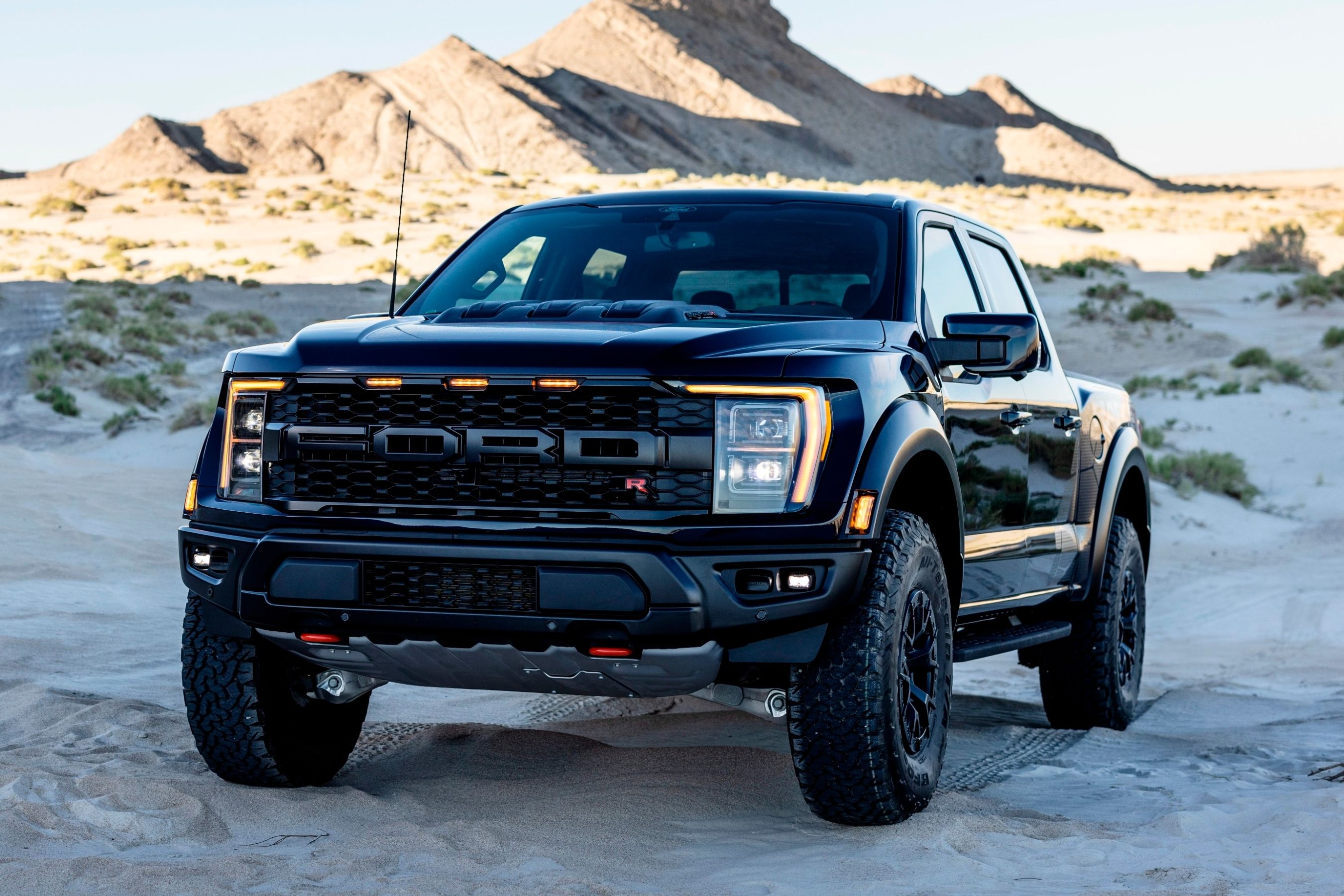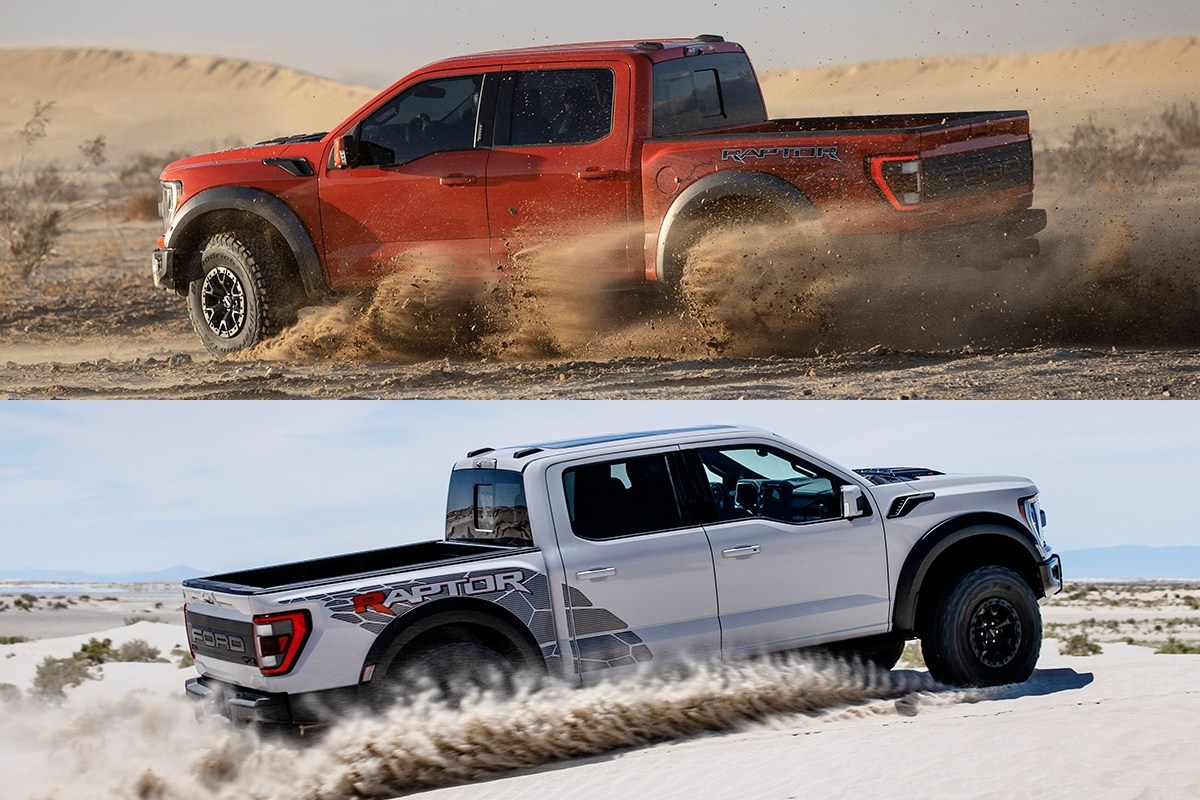
It's been around 18 months since Ford confirmed that the F-150 Raptor R was coming with V8 power. Now that the monster pickup has been unveiled, Ford finally has a legitimate Ram 1500 TRX rival. But perhaps the question isn't whether one should go for the Raptor R or TRX, but rather, is the Raptor R worth over $35,000 more than the already capable Raptor? To help us answer that question, we've broken down all the differences - both big and small - between the Raptor and Raptor R.
Horsepower: A 250-HP Gulf
This one is obvious. For many, the mere sound of the Raptor R's V8 will be enough reason to choose it over the regular Raptor. The latter has a 3.5-liter twin-turbocharged EcoBoost V6 producing 450 horsepower and 510 lb-ft of torque. The Raptor R tosses out the V6 for a 5.2-liter supercharged V8 making 700 hp and 640 lb-ft. That's a gulf of 250 hp and 130 lb-ft, which is not exactly minimal. We're familiar with the Raptor R's engine from the Mustang Shelby GT500, and here it has a recalibrated supercharger and a new pulley. This increases low-end and mid-range torque, which benefits off-road scenarios. In addition, air intake volume has been increased by 66% to help it breathe better.
Numbers tell only one part of the story. As the video below demonstrates, the roar of the V8 dramatically enhances the character of the pickup. The regular Raptor's V6 is a powerful engine and sounds good enough, but the Raptor R's V8 blows it away.
Performance: No Contest
The sheer power advantage in favor of the Raptor R means that the regular Raptor simply won't be able to keep up in a straight line, not that pickups weighing over 5,500 pounds are ideal dragsters. Ford hasn't specified 0-60 times for the Raptor R, but it should be able to accomplish the task in comfortably under five seconds. We already know that the V6 Raptor can do the same in about 5.5 seconds, which is more than fast enough for a full-size truck. The Raptor's best chance of chasing down the Raptor R is to hope that the V8 drains its tank so that the presumably more efficient EcoBoost V6 has half a chance.
Towing And Payloads: A Closer Call
As fast as these trucks are, the Raptor R's extra grunt will rarely be needed for day-to-day use. More importantly, both pickups will need to put in a strong showing when it comes to towing or carrying heavy loads in the bed. The maximum payload capacity for both is 1,400 lbs, so they're evenly matched here. In terms of conventional towing, the Raptor maxes out at 8,200 lbs and the Raptor R can manage 500 lbs more at 8,700 lbs. In this area, the Raptor isn't embarrassed by its angrier sibling.
Off-Roading: Two Of The Best
Both Raptors are equipped to withstand some serious abuse. Each has front and rear FOX Racing shocks with electronically controlled continuously variable compression damping. Ford says that the FOX Live Valve shocks have been uniquely tuned to take advantage of the more powerful Raptor R's V8. Each has a five-link rear suspension, but the Raptor R's front axle has a stronger carrier casing and an aluminum-ribbed structural cover that can withstand the V8's higher torque.
As standard, the F-150 Raptor rides on 35-inch tires whereas the Raptor R gets 37s by default - these larger tires are optional on the base Raptor. Front/rear suspension travel is 14/15 inches respectively for the Raptor and 13/14.1 inches for the R. Those 37-inch tires do mean that the Raptor R has a wider turning circle of 50 feet, up from the Raptor's 48 feet.
13.1 inches of ground clearance gives the Raptor R the edge, 1.1 inches more than the standard Raptor. Likewise, approach/departure/breakover angles of 33.1/24.9/24.4 degrees respectively for the Raptor R are better than the Raptor's 31/23.9/22.7-degree angles.
The Raptor R's changes are primarily to compensate for its extra power and torque, but when the standard Raptor is properly equipped, both can jump over sand dunes and clamber over rocks better than almost everything else. But you'll likely enjoy these antics much more when accompanied by the sound of that V8.
Dimensions: A Lot Of Truck
Both Raptors are only available in the SuperCrew format so share a 145.4-inch wheelbase, a 232.6-inch length, and an overall width of 96 inches. There are, however, a few differences. With its fatter rubber, the Raptor R is 0.8 inches taller at 80.6 inches. Its body is a fraction wider without the mirrors, and it has a wider front track (74.3 inches vs 74 inches) and rear track (73.9 inches vs 73.6 inches). Both trucks can accommodate the same volume of cargo at 52.8 cubic feet.
Value: A Bronco-Sized Price Gap
At $109,145, including destination, the new Raptor R is a staggering $36,795 more expensive than the regular Raptor. With the V6, the Raptor costs $72,350, including destination. That $36,796 could buy you a Bronco Big Bend on its own.
That price difference is substantial and the bulk of it goes towards the Raptor R's sensational V8. It's faster than the regular Raptor, sounds better, and looks a bit meaner. It's also more capable as standard with the fatter rubber, but the differences are negligible in some instances.
If money is no object and you want the hottest F-150 you can buy, the Raptor R is it. But the standard Raptor has not by any means been rendered irrelevant.

